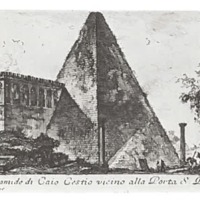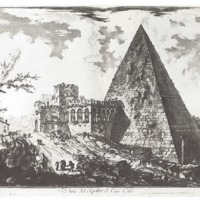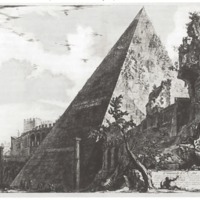Piranesi
Over the course of his time etching in Rome, Giovanni Battista Piranesi (1720-1778) became obsessed with a few different monuments, which he returned to again and again as his style and interests evolved. The Pyramid of Cestius was one of these monuments. The progression of prints of the Pyramid is shown below:
In the 1745 portfolio Varie Vedute, Piranesi begins to depart from the more traditional style of his master of the previous five years, printmaker Giuseppe Vasi. The top of the pyramid rises up and over the top edge of the plate in an illusionistic manner.1 His Vedute di Roma (editions from 1751 until his death in 1778) plates were much larger than the Varie Vedute, allowing for greater detail and Piranesi's expression of the monumentality of Rome's public spaces.2 His depictions of light become more painterly and descriptive. The surface is cleared of vegetation in order for the edges and inscriptions to be more visible. Wilton-Ely calls this a "factual statement of exaggerated force."3
Piranesi was seeing the Pyramid as both artist and archaeologist when he returned to it again in 1756 for the Antichita Romane portfolio.4 He flexes his engineering training (which he received from his uncle, an engineer for the Venetian waterworks) to produce something more like an archaeological illustration, with a sharp focus and higher level of detail than the Vedute.5 The Pyramid, now viewed from a low vantage point, rises above the viewer almost dizzyingly, grazing the top of the plate.
He returned to the Vedute sometime before 1760 and radically recut the plate of the Pyramid of Cestius. The vantage is from roughly the same height as the Antichita, rising from the very bottom to the very top of the plate. The leftmost edge of the Pyramid forms a strong diagonal between the ruins and trees of the bottom right portion and the wide open sky of the top left. The trees (almost entirely erased from the Antichita) are back with a vengeance, digging their gnarled roots into the ancient structures.6
(Piranesi’s etchings depict the exterior of the monument. For interior views, see Pietro Santi Bartoli’s etchings of the interior on another page.)
______________________________________________________________________________
- John Wilton-Ely, The Mind and Art of Giovanni Battista Piranesi (London: Thames and Hudson, 1978), 31.
- Wendy Thompson, “Giovanni Battista Piranesi (1720-1778),” Heilbrunn Timeline of Art History (New York: The Metropolitan Museum of Art, October 2003), http://www.metmuseum.org/toah/hd/pira/hd_pira.htm.
- John Wilton-Ely, The Mind and Art of Giovanni Battista Piranesi (London: Thames and Hudson, 1978), 36.
- Ibid, 36-38.
- Wendy Thompson, “Giovanni Battista Piranesi (1720-1778),” Heilbrunn Timeline of Art History (New York: The Metropolitan Museum of Art, October 2003), http://www.metmuseum.org/toah/hd/pira/hd_pira.htm.
- John Wilton-Ely, The Mind and Art of Giovanni Battista Piranesi (London: Thames and Hudson, 1978), 40.



